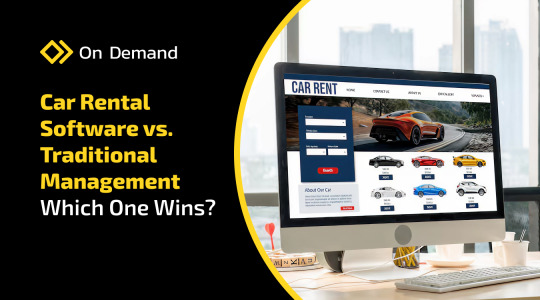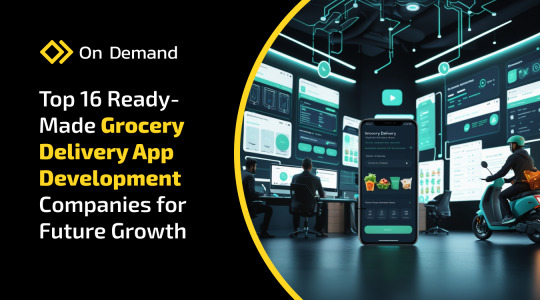Our On-Demand App Solutions provide a comprehensive platform for creating fully customized, end-to-end solutions tailored to your unique needs. We offer a variety of ready-made white-label mobile app solutions, including doctor appointment apps, salon booking apps, truck booking apps, laundry service apps, and more. Additionally, we specialize in clone solutions, such as Amazon clones, eBay clones, fashion e-commerce clones, furniture e-commerce clones, and beyond. Whether you're looking to develop a mobile app or a clone solution, feel free to contact us for more information or visit our website.
Don't wanna be here? Send us removal request.
Text
Comparing Car Rental Software & Traditional Management

The rapid digitization of the mobility sector has left traditional rental operations lagging behind. With complex booking processes and limited scalability, car rental businesses struggle to meet growing customer expectations. Choosing between Car Rental Software vs Traditional Management is no longer a luxury but a necessity. As the car rental market surges toward $261 billion by 2029, understanding this comparison is crucial for businesses that want to keep pace.
Key Drivers Behind the Shift to Car Rental Software
1. Automation Reduces Manual Workloads
Car rental software automates tedious tasks like bookings, dispatch, and invoicing, enabling operators to focus on growth and customer service.
2. Improved Fleet and Driver Management
From fuel consumption tracking to real-time location updates, software provides transparency and operational control that traditional systems lack.
3. Enhanced Customer Experience
Modern users expect instant updates, seamless payments, and mobile-first interactions. Software delivers all of this through intuitive apps and web interfaces.
4. Data Security and Fraud Prevention
Traditional paperwork is prone to errors and loss. Car rental software stores e-signed contracts securely and uses AI-based ID verification to prevent fraud.
5. Real-Time Analytics for Informed Decisions
Operators can track revenue trends, booking patterns, and operational metrics instantly, allowing them to make smarter, data-driven decisions.
6. Scalable and Future-Ready Architecture
Cloud-based systems allow businesses to expand to new markets without additional infrastructure costs. Integrations with GPS, insurance, and payment systems make scaling seamless.
Conclusion
The advantages of using car rental software are evident across every touchpoint—from improved operational efficiency to customer satisfaction and long-term scalability. To explore custom solutions tailored to your business, platforms like on-demand-app.com offer cutting-edge tools that empower you to grow confidently in this digital age. In the ongoing battle of Car Rental Software vs Traditional Management, the digital route is clearly winning—and it’s time your business followed suit.
Read more: Car Rental Software vs. Traditional Management Guide
1 note
·
View note
Text
White Label Car Rental App Solution: Full Guide for Startups

As digital innovation sweeps across industries, car rental businesses are shifting gears by embracing mobile solutions. The global user penetration for car rental apps is projected to reach 8.3% in 2025 and rise to 10.1% by 2029. This rapid growth signals a huge opportunity for businesses looking to scale quickly with a Car Rental App Development Company.
Key Drivers Behind the Surge in White-Label Car Rental Apps:
1. Scalability Without Complexity
White-label car rental solutions eliminate the burden of starting from scratch. These pre-built apps can be customised to match brand identity while providing robust backend infrastructure.
2. Quick Time-to-Market
Launching your car rental service fast is essential in a competitive landscape. A white-label solution can go live in as little as 15 days—an edge that helps capture early adopters and generate faster ROI.
3. Cost-Efficiency
Unlike bespoke development, white-label apps slash R&D, testing, and maintenance costs. The savings can be channelled into branding or marketing, increasing long-term business viability.
4. Flexibility & Customisation
Whether you're a startup or an enterprise, the adaptability of white-label solutions allows for seamless UI/UX personalisation, third-party integration, and scalable features that evolve with your business.
5. Compliance & Security
Top vendors ensure their apps meet regional legal standards and data security protocols. That includes encryption, GDPR compliance, and reliable payment gateway integrations.
6. End-to-End Support
With ongoing maintenance and technical assistance offered by providers, rental businesses can focus more on growth and less on tech hurdles.
Challenges and Considerations:
While white-label apps bring speed and efficiency, businesses may face limited customisation or require additional expert support for advanced features. It's important to partner with a reliable vendor like on-demand-app.com to ensure long-term success.
Conclusion:
White-label car rental solutions have become the go-to option for modernising rental operations without draining resources. By partnering with an experienced provider, businesses can quickly enter the digital arena, stand out from competitors, and meet evolving customer demands. Whether you're scaling or just starting, the combination of speed, cost savings, and reliability offered by white-label car rental solutions is hard to overlook. Step into the future of mobility, your journey starts here.
Read more: Startup Guide to White Label Car Rental App Solutions
1 note
·
View note
Text
Top 13 Quick Commerce Firms Transforming Indian Retail

The rise of quick commerce companies in India is revolutionizing the retail game, making lightning-fast delivery the new normal. These platforms are meeting the demands of speed-driven consumers, reshaping how people shop for groceries, fashion, and daily essentials. With the support of changing user behaviors, higher disposable incomes, and technological innovation, quick commerce has quickly transformed from a niche concept into a nationwide movement.
Key Drivers Fueling the Quick Commerce Boom:
1. Market Expansion & User Growth
Between 2020 and 2025, the gross merchandise value jumped from $0.1 billion to $5.3 billion, and user penetration increased from 7% to 12.5%. This growth shows that Indian consumers are embracing the convenience of on-demand app solutions more than ever before.
2. Speed and Reliability
From groceries to fashion, companies like Blinkit, Zepto, and Swiggy Instamart are setting new benchmarks with 10-minute delivery promises powered by dark stores and streamlined logistics.
3. Diverse Brand Involvement
From fresh meat delivery by FreshToHome to fashion drops via Slikk and Flipkart, Minutes’ wide-ranging products, India’s top players are racing to meet consumer demand through specialized services.
4. Urban Lifestyle & Convenience
The hustle of metro life demands speed, and quick commerce platforms are rising to the occasion. Whether it’s milk at dawn from Milkbasket or medicines from Dunzo Daily, the market is centered around lifestyle enhancement.
5. Future-Ready Infrastructure
Amazon Fresh and BigBasket are now expanding their distribution centers and adopting AI for better inventory control. They’re not just delivering products—they’re building ecosystems around convenience and efficiency.
Conclusion:
The adoption of free delivery management software and data-backed logistics is the backbone of this rapid delivery revolution. As consumer expectations soar, businesses must adapt quickly or get left behind. Investing in quick commerce app development is no longer optional—it’s essential for survival. With the right tools and vision, brands can capitalize on this trend and deliver unmatched value to their customers Read more: India's Leading 13 Quick Commerce Startups in 2025
1 note
·
View note
Text
Top Quick Commerce Companies Driving India's Retail
Quick commerce is revolutionizing shopping in India! 🛒⚡ With deliveries in 10 minutes, it's reshaping how we buy groceries, fashion, and more. Explore the top 12 companies driving this change and see why speed is the new standard in retail!Read more: https://on-demand-app.com/indian-retaitop-13-quick-commerce-companies-in-india-top-players-reshapingl?preview=true

1 note
·
View note
Text
Indian Retail Top 13 Quick Commerce Companies in India Top Players Reshaping Indian retail
Quick commerce is exploding in India, reshaping how we shop with 10-minute deliveries! Want to keep up? Build your own quick commerce app with on- demand apps and lead the next-gen retail revolution.
1 note
·
View note
Text
Top 16 Grocery App Development Companies for Future Growth
Retail evolution is here! The online grocery market is surging, projected to hit $659.7B by 2025 with a 21.6% CAGR. Stay ahead with a white-label grocery delivery app for seamless operations. Build yours today with the On-Demand App!
1 note
·
View note
Text
Top 16 Grocery App Development Firms for Success

The grocery delivery market is evolving rapidly, with businesses seeking faster and more cost-effective solutions to stay competitive. A ready-made grocery delivery app development solution offers a quick way to launch a branded platform with minimal effort, helping businesses streamline operations and meet growing consumer demands.
Key Drivers of Grocery Delivery Market Growth
1. E-Commerce Boom
The dominance of online shopping has reshaped consumer behaviour, increasing demand for seamless grocery delivery solutions.
2. Speed & Convenience
Instant delivery models like 15-minute grocery services are setting new industry benchmarks for customer expectations.
3. Sustainability Trends
Consumers are shifting toward eco-friendly brands that focus on sustainable packaging and carbon-neutral delivery.
4. Enhanced Payment Security
Digital wallets and BNPL (Buy Now, Pay Later) options make online grocery shopping more convenient and accessible.
5. AI & Smart Logistics
Businesses are leveraging AI-powered recommendations and efficient last-mile delivery networks to optimise service quality.
The Competitive Edge of Ready-Made Solutions
With fierce competition in the grocery delivery space, businesses need a reliable and scalable platform to ensure a smooth user experience. White-label and on-demand apps provide pre-built frameworks that can be customized to match a brand’s identity, reducing development time and cost.
Conclusion
As digital transformation accelerates, businesses must adapt to shifting consumer demands. By investing in on-demand apps, grocery retailers can enhance efficiency, improve customer experience, and stay ahead in the competitive online grocery market.
Read more: Best 16 Grocery App Developers for Future Growth
0 notes
Text
16 Best Grocery Delivery App Developers for Growth
Launch your grocery delivery business effortlessly with a ready-made white-label app. Streamline operations, enhance customer engagement, and boost sales with customisable, feature-rich platforms. The online grocery market is projected to hit $659.7 billion by 2025, growing at 21.6% CAGR. Stay ahead with AI-powered automation, real-time tracking, and secure payments. Explore top app development companies offering scalable solutions for digital success. Get expert assistance and build your grocery delivery app today!
1 note
·
View note
Text
Top 16 Firms for Grocery Delivery App Development
🚀 The online grocery market is booming, set to reach $659.7B by 2025! 📈 Stay ahead with white-label grocery delivery apps—customizable, scalable, and built for success. Discover top developers who can help you launch fast and efficiently. Get started today!
Read more: https://on-demand-app.com/top-16-ready-made-grocery-delivery-app-development-companies-for-future-growth

#GroceryDelivery#EcommerceGrowth#WhiteLabelApps#RetailTech#OnlineShopping#AppDevelopment#ITSolutions
1 note
·
View note
Text
5G App Development Trends: Transforming On-Demand Services
Want to stay ahead in 5G app development trends? Leverage 5G technology to revolutionize real-time tracking, cloud computing, and IoT-powered on-demand apps. Whether it's ride-hailing or food delivery, 5G delivers lightning-fast speeds, ultra-low latency, and an enhanced user experience. Accelerate your success with pre-built solutions designed for quick market entry and seamless scalability. For more details, visit our website or explore our blog.
1 note
·
View note
Text
5G App Development Trends Shaping Next-Gen On-Demand Solutions
🚀 Explore how 5G revolutionizes mobile app development with lightning-fast speeds and ultra-low latency! 📱 From cutting-edge on-demand solutions to seamless cloud-based apps, 5G unlocks endless innovation. Stay ahead of the curve and elevate your business with next-gen mobile experiences!
Read more: https://on-demand-app.com/the-impact-of-5g-on-the-future-of-on-demand-app-services

0 notes
Text
How 5G is Transforming On-Demand App Development

The rise of 5G technology is reshaping the landscape of mobile app development, especially for on-demand app services. With ultra-fast speeds, minimal latency, and improved connectivity, businesses can now deliver seamless user experiences and optimize real-time operations.
The Impact of 5G on On-Demand App Development
1. Unmatched Speed and Performance
5G delivers speeds up to 100 times faster than 4G, ensuring instant data processing. This is crucial for apps in ride-hailing, food delivery, and e-commerce, where real-time updates are essential.
2. Enhanced User Experience
The improved bandwidth allows mobile apps to support high-definition streaming, AR/VR experiences, and interactive features. For instance, a ride-hailing app can integrate AR-based navigation for better customer engagement.
3. Cloud-Powered Efficiency
With 5G, on-demand apps can offload complex processing to cloud servers, reducing the burden on user devices. This results in optimized performance, better battery life, and faster data access for apps like logistics tracking and healthcare consultations.
4. Seamless IoT Integration
5G supports up to 1 million connected devices per square kilometer, making IoT-powered mobile apps more efficient. Smart home automation, real-time shipment tracking, and wearable tech will benefit immensely from this advancement.
5. The Rise of Pre-Built App Solutions
Businesses looking to leverage mobile app development without high costs are turning to pre-built solutions. These platforms come with integrated 5G capabilities, reducing development time and expenses while ensuring scalability and advanced functionality.
Challenges and Future Opportunities
Despite its potential, 5G adoption in on-demand app development comes with challenges like security risks and infrastructure costs. However, integrating blockchain for data security and edge computing for improved efficiency can unlock new opportunities in this space.
Conclusion
5G is set to revolutionize mobile app development, making on-demand apps faster, smarter, and more efficient. Businesses that embrace this technology early will gain a competitive edge in the evolving digital marketplace
Read more: The 5G Revolution: Transforming On-Demand App Development
0 notes
Text
The Impact of 5G on the Future of On-Demand App Services
Stay ahead in 5G app development trends with enhanced real-time tracking, cloud computing, and IoT integration. From ride-hailing to food delivery, 5G technology ensures faster speeds and seamless experiences. Explore pre-built solutions for quick market entry and scalability. https://on-demand-app.com/the-impact-of-5g-on-the-future-of-on-demand-app-services
1 note
·
View note
Text
Build a Profitable Handyman App Like TaskRabbit in 2025
On-Demand stands out as a premier company offering top-tier Handyman Services tailored to meet your business needs. Their innovative on-demand handyman app bridges the gap between customers and skilled service providers, facilitating a wide range of home repairs and maintenance tasks such as plumbing, cleaning, and more. For a deeper dive into their offerings, explore their detailed blog.
1 note
·
View note
Text
Master the Art of Creating an On-Demand Handyman App Like TaskRabbit in 2025
🚀 The on-demand handyman app market is booming! 🌟 Dive into this comprehensive guide to learn how to build a powerful app like TaskRabbit. From features to monetization strategies, we've covered it all. Stay ahead of the competition and tap into this $1.7 trillion industry! 💰
Read more: https://on-demand-app.com/building-a-profitable-on-demand-handyman-app-like-taskrabbit-in-2025

1 note
·
View note
Text
Step-by-Step Guide to Developing a Profitable Handyman Service App

The rise of on-demand handyman apps has transformed how customers access home services, creating a lucrative opportunity for entrepreneurs. With the global market projected to hit $1.7 trillion by 2030, the demand for on-demand app solutions like TaskRabbit is skyrocketing. These apps bridge the gap between service providers and customers, offering convenience, efficiency, and reliability. If you’re planning to enter this thriving industry, this guide will walk you through the essentials of home services app development, ensuring a seamless and profitable journey.
Why Invest in an On-Demand Handyman App?
The on-demand handyman apps market is booming, driven by the increasing reliance on smartphones for booking services. Apps like TaskRabbit have set the standard, allowing users to hire professionals for tasks like plumbing, cleaning, and electrical work with just a few taps. Building an on-demand app in this niche offers immense benefits, including access to over 2 billion smartphone users worldwide, recurring revenue streams through commissions and subscriptions, and improved customer retention with features like real-time tracking and secure payments.
Step 1: Research and Plan Your App
A successful on-demand handyman app like taskrabbit starts with thorough research. Identify your target audience—individuals or businesses—and understand their needs. Ask critical questions: What services will your app offer? How will it stand out from competitors like TaskRabbit? Focus on flexibility and user convenience, as these are key differentiators in the home services app development space.
Step 2: Must-Have Features for Your App
The success of your on-demand app hinges on its features, for the customer app, including user registration, service categories (e.g., plumbing, cleaning), real-time tracking, secure payments, and ratings/reviews. For service providers, offer profile management, job request details, and an earnings dashboard. The admin dashboard should include user management, analytics, and dispute-resolution tools.
Step 3: Choosing the Right Tech Stack
A robust tech stack is crucial for your on-demand handyman app. For front-end development, consider React Native or Flutter. Backend development can be powered by Node.js, Python, or Ruby on Rails. Use MySQL or MongoDB for the database, Firebase or PubNub for real-time updates, and Stripe or PayPal for payment processing. Cloud hosting options like AWS or Google Cloud ensure scalability and security.
Step 4: Monetization Strategies
Sustainability depends on effective monetization. Charge a service commission on each transaction, offer subscription plans for premium features, or generate revenue through in-app ads. You can also allow professionals to pay for featured listings to appear higher in search results.
Step 5: Development Costs
The cost of home services app development varies based on complexity, features, and region. UI/UX design typically costs $5,000-$10,000, while frontend and backend development can range from $20,000-$50,000. Testing and QA may add $5,000-$8,000, with annual maintenance costing $2,000-$5,000. A basic app may cost $30,000-$40,000, while a feature-rich app like TaskRabbit can go up to $100,000.
Step 6: Marketing and Launch
A successful launch requires a solid marketing strategy. Use pre-launch campaigns, social media ads, and referral programs to build buzz. Optimize your app store listing with App Store Optimization (ASO) techniques to boost visibility.
Future Trends in On-Demand Handyman Apps
To stay competitive in 2025, embrace trends like AI-powered matching, AR for virtual consultations, and sustainability features that highlight eco-friendly services.
Conclusion
Building an on-demand handyman app in 2025 is a promising venture, but it requires meticulous planning, advanced technology, and a customer-centric approach. By leveraging this guide and partnering with experienced developers, you can create a successful app that taps into this booming market. Start your journey today and stay ahead of the competition!
Read More: Building a Profitable On-Demand Handyman App Like TaskRabbit in 2025
1 note
·
View note
Text
Building a Profitable On-Demand Handyman App Like TaskRabbit in 2025
On-Demand offers exceptional Handyman Services tailored to your needs. Enjoy easy booking, real-time professional tracking, secure payments, and quality assurance through ratings and reviews. Their seamless platform ensures efficient home maintenance solutions. Visit their website to learn more about their reliable and convenient services.
1 note
·
View note